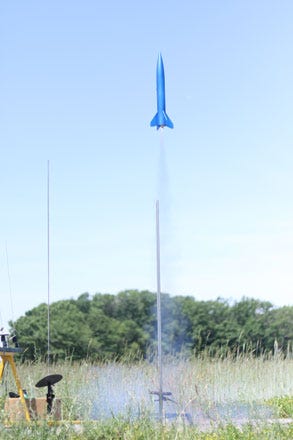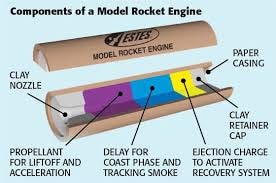As part of our efforts to counter the effects of decades of digital involution, Tom Swift is launching a new series of articles providing a comprehensive outline of the Great Pursuits. To this end, our first report shall outline the basics of model rocketry. Model rocketry is one of the best possible ways to learn the fundamental principles of physics. It instills a sense of wonder in the laws of classical mechanics, and allows a rare glimpse into the fundamental technology of the Space Age. Due to its electrical and mechanical components, it is perhaps one of the best alternatives to digital involution.
It is not expensive, necessary materials include cardboard, wood glue and small engines which can be purchased any decent hobby store. These engines work as follows:
One can launch model rockets wherever good flat land is to be found. In some locations, this can be hard to find, but public soccer or baseball fields are excellent launching locations during the off season, at least in the smaller metropolitan areas. There are many lessons one can learn from a model rocket. It is one of the best ways to demonstrate principles of trigonometry, as the calculation made with a plastic altimeter and baseline will demonstrate the concepts of sine, cosine and tangent in a particularly memorable way. The workings of the rocket equation can be demonstrated by measuring flight time, and observing the mass of the spent fuel by weighing the rocket before and after launch. For these reasons model rockets are some of the best tools possible for demonstrating the principles of physics.
Lest one believe that only the laws of mechanics can be learned from model rockets, it must be stated that they are excellent vectors for delivering electronic payloads. It is indeed edifying to study the recorded output of an accelerometer mounted to the nose cone of a model rocket. One can also obtain aerial photographs with miniature cameras, and take many other forms of measurement as well. In short, model rocketry provides a plethora of interesting problems for the builder of application specific computers. The principles of avionics remain the same at all scales.
Many great men of science have practiced this pursuit in their youth, perhaps most notably Robert Goddard and Wernher von Braun. The story of their lives offers a portrait of the development of the liquid-fueled rocket, and a grave warning for our time. There lives were intertwined in a way few understand today. For Robert Goddard went on to develop the fundamentals of liquid-fueled propulsion, but was stymied as he failed to secure the necessary funding to scale up his designs during the Great Depression. While Robert tried in vain to convince the United States government of the merits of his liquid fueled technology, Wernher studied the results Robert’s research, and used these findings in his development of the V-2. Backed by the practically unlimited resources of Nazi Germany, the V-2 reached the edge of space repeatedly on its parabolic trajectories to English targets . In the aftermath of the Second World War Robert Goddard finally saw the captured V-2s based on his ideas and designs. It is for this reason that America learned the hard lesson that invention alone is not sufficient. Such is the cost of short term thinking.
America took no such chances in Cold War efforts to counter the technological might of the Soviet Union It was in this massive wave of scientific interest during the early stages of the Cold War that model rocketry first became a widespread hobby.
If you would like to know more, upgrade to paid!
Keep reading with a 7-day free trial
Subscribe to Tom Swift to keep reading this post and get 7 days of free access to the full post archives.






